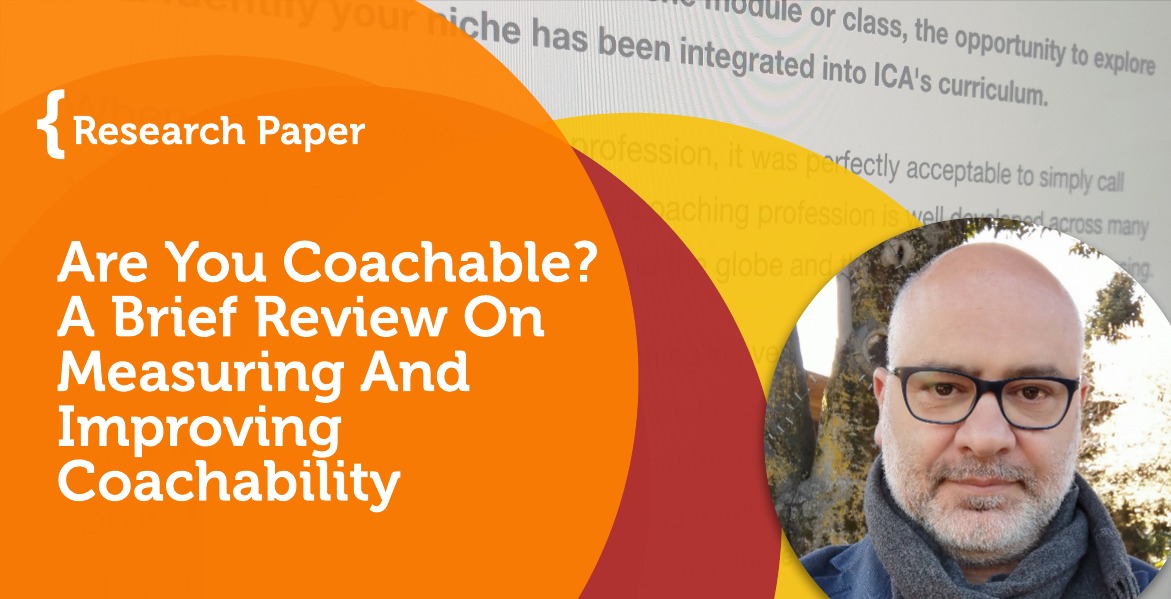 Research Paper By Michele Longobardi
Research Paper By Michele Longobardi
(Executive Coach, ITALY)
Are You Coachable? A Brief Review On Measuring And Improving Coachability
In the practice of coaching the coachee may be more or less ready to face openly any kind of change and the coaching path can be unsatisfactory or experienced as counterproductive.
Although this can happen quite frequently in many programs when client and coachee are not the same people – for example in specific cases with post-assessment coaching program in business contexts, where the paths can be very structured and the company objectives influence in a way those of the coachee – it may also occur in less structured situations, where the client may appear disoriented, not “ready” to get involved in the face of the coach’s stimuli.
We may notice the coachee strongly defending current decisions or ideas, or he/she is not available to consider other points of view, does not accept feedback, or is driven to be right.
“Coach instinct” can therefore lead us to do an internal check to understand if we have done everything in our power to put the coachee at ease if we have followed ethical principles, and put our coaching skills into play in a proper way. Certainly, supervision or intervention can help us improve in any case, but familiarizing ourselves with the concept of coachability can be equally useful for us and especially our client.
What is meant by Coachability?
We can define “Coachability” as the readiness to develop oneself and to consider change opportunities that may arise within a coaching program. It implies also the openness to accept feedback and stimuli, to dive into different perspectives and points of view.
Even more recently the concept has been highlighted in a review [1] about coachability of entrepreneurs, considered as a positive factor that influences their openness to change and consequently their attractiveness for potential investors: the more coachable you are, the more a potential investor will be willing to finance your business.
Bacon and Voss found different factors that have an impact on coachability [2]:
Starting from these factors, they proposed a framework describing 7 levels of coachability:
What I found very useful in this scale, is the subdivision into 3 sets of indicators for each level, described as:
Here is the C6 level as described by the authors.
 While the first 2 give an idea of what kind of events or attitudes the coachee may refer to, the last one may really help to understand if there is space for improvements and how to introduce changes.
While the first 2 give an idea of what kind of events or attitudes the coachee may refer to, the last one may really help to understand if there is space for improvements and how to introduce changes.
Further – except the level C0 – the authors suggest sharing with the clients your evaluation to increase their self-awareness and commitment and define a starting point to build a strong coaching agreement.
But what we can do to improve the client’s coachability?
Lisa Haneberg [3]affirms that one purpose of coaching is to improve coachability and suggests several techniques to do it. Some of them are:
Conclusion
Coaching practice is always very stimulating, even for the coach. It always puts you in a perspective of challenge and continuous improvement, but above all it helps you to be in touch with yourself and with your clients, improving sensitivity and listening skills.
The concept of coachability also goes in this direction: its application requires us to make an extra effort in listening to our client, being in the here and now, to understand what he feels and what can help him to overcome the difficulty of the moment.
At the same time, it challenges our “intent” as a coach, renews the personal purpose that led us to choose this profession, and stimulates the relationship with the client.
Reference
Betting on the Coachable Entrepreneur: Signaling and Social Exchange in Entrepreneurial Pitches. Michael P. Ciuchta, Chaim Letwin, Regan Stevenson, Sean McMahon, and M. NesijHuvaj. Entrepreneurship Theory and Practice 2018, Vol. 42(6) 860–885
Adaptive Coaching: The Art and Practice of a Client-Centered Approach to Performance Improvement, Bacon, Terry R., Voss, Laurie.2003
Organization Development Basics– ASTD Press, December 15, 2005, Lisa Haneberg